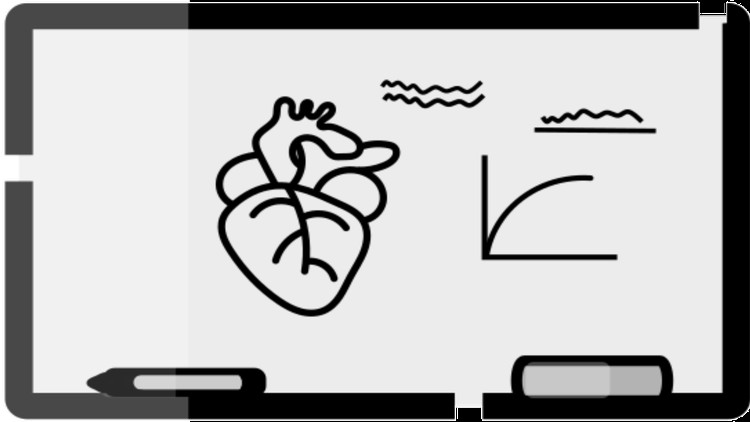The basic anatomy of the heart including the borders,surfaces and grooves.
The internal and external anatomy of the various chambers of the heart.
The various blood vessels, nerves and lymphatics that supply the heart.
The basics of cardiac electrophysiology and the mechanisms for the resting and action potentials in the heart.
The various phases of the cardiac cycle and the graphs related to the cardiac cycle.
The basics of heart mechanics including the concepts of preload,afterload and contractility. Application of these concepts in the managment of heart failure.
The different factors that influence the cardiac output and venous return. Interpretation of the cardiac output/venous return curves.
The basics that govern the flow of blood in the cardiovascular system. The concept of series and parallel circuits.
The special circulations in the body.
The difference between laminar and turbulent blood flow and the reynold’s number.
The difference between systolic and diastolic blood pressures and how blood pressure is regulated in the body.
This is a detailed course on the anatomy and physiology of the heart. The course consists of whiteboard lectures, and is divided into several different sections. Various anatomical parts of the heart are explained using a 3d model of the heart.
The first few lectures deal with various aspects of the basic anatomy of the heart like the surfaces,borders and grooves of the heart. The next two sections are dedicated to the outer covering of the heart known as the pericardium and the fibrous skeleton. The blood,nervous and lymphatic drainage of the heart are discussed in separate sections. Finally there is section about the various chambers of the heart.
Get Instant Notification of New Courses on our
Telegram channel.
Note➛ Make sure your 𝐔𝐝𝐞𝐦𝐲 cart has only this course you're going to enroll it now, Remove all other courses from the 𝐔𝐝𝐞𝐦𝐲 cart before Enrolling!
The first section of physiology deals with the electrophysiology of the heart. The section describes starts with the basics of electrophysiology and then discusses core electrophysiological concepts like resting membrane potential and action potential. The subsequent sections related to physiology cover topics including the heart mechanics, cardiac output and venous return and the cardiac cycle. Finally, the last topic of this course is related to hemodynamics. Various hemodynamic priniciples are discussed in this section and all the main vessels including arteries,arterioles,capillaries,veins and venules are discussed in this section.
It should be noted that this course is only for educational purposes and information provided in this course is not intended to guide medical decision making.
Heart Anatomy Basics
Basic Anatomy of the Heart
Heart Anatomy Basics – The Apex and the Base
Surfaces of the Heart
Grooves and Borders
Chambers, Surfaces and Borders
Surface Marking of the Heart
The Pericardium
The Pericardium part 1
The Pericardium part 2 – The Pericardial Sinuses
The Fibrous Skeleton of the Heart
The Fibrous Skeleton of the Heart
The Blood Circulation of the Heart
The Blood Circulation of the Heart
The Nervous Supply to the Heart
Basics of the Autonomic Nervous System
The Cardiac Plexus
The Symphathetic and Parasympathetic Effects on the Heart
The Afferent Supply from the Heart
The Lymphatic Drainage from the Heart
The Lymphatic Drainage from the Heart
The Electrophysiology of the Heart
Concept of potentials
The Resting Membrane Potential
The Action Potential
Conduction Pathways in the Heart
The Cardiac Excitation Contraction Coupling
Pacemakers of the Heart
The ECG Basics – Waves in the ECG
The Chambers of the Heart
Introduction to the Chambers of the Heart and the Right atrium
Right Atrium – Embryology
Right Ventricle – Anatomy
Right ventricle – Physiology
Right Ventricle – Physiology part 2 – Pulsus paradoxus
Left Atrium
Left Ventricle
The Cardiac Cycle
The Cardiac Cycle
The Cardiac Cycle Graphs Part 1
The Cardiac Cycle Graphs Part 2
Heart Mechanics
The Heart as a Pump
Heart Mechanics – Preload part 1
Heart Mechanics – Preload part 2
Heart Mechanics – Preload part 3 – CVP and JVP
Cardiac Contractility Part 1
Cardiac Contractility – Part 2 – Molecular Mechanisms of Contractility
Cardiac Contractilty – Part 3 – Causes of Increased Contractility
Cardiac Contractility – Part 3 continued…Causes of Decreased Contractility
Cardiac Afterload and Remodelling
Pressure Volume Loops
Cardiac Output and Venous Return
Cardiac Output and Venous Return part 1
Cardiac Output and Venous Return Part 2
Cardiac Output and Venous return Part 3
Hemodynamics
Basics of hemodynamics
The Arteries
Arterioles, Metarterioles and Capillaries
The Capillaries Part 1- Histology
The Capillaries Part 2- Physiology
The Special Circulations
The Circulation in the Skin
The Renal Circulation
The Circulation in the Skeletal Muscle
The Circulation in the Heart
The Circulation in the Liver and Splanchnic organs
The Pulmonary Circulation
The Cerebral Circulation
Veins and Venules
Blood Flow – Part 1- Laminar and Turbulent Flow
Blood Flow – Part 2 – Reynold’s number, Flow Velocity and Korotkoff Sounds
Blood Flow – Part 3 – Clinical Applications
Blood Pressure and its control
Short Term Regulation of Blood Pressure
Long Term Regulation of Blood Pressure
Attributions
Attributions
